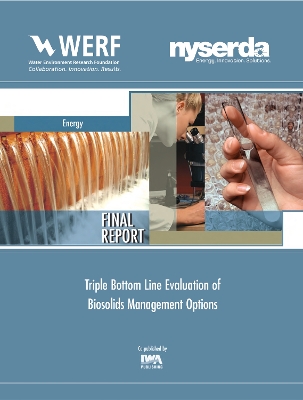WERF Research Report
2 total works
Triple Bottom Line Evaluation of Biosolids Management Options
by Steve Tarallo
Published 3 November 2015
The overall goal of this energy project was to aid water resource recovery facilities (WRRF) in moving toward "net-zero" energy use through near-at-hand practices and technologies in the areas of energy conservation, demand reduction, and enhanced production. Many WRRFs looking to become Utilities of the Future are using Triple Bottom Line (TBL) assessments to inform decisions about opportunities for long term sustainability, and to evaluate common wastewater solids management technologies and processes amenable for energy recovery based on social and environmental impacts, as well as financial metrics.
Funded through a collaborative effort between the New York State Energy Research and Development Authority (NYSERDA) and the Water Environment Research Foundation (WERF), researchers used a TBL approach to evaluate common wastewater solids management technologies and processes relative to their potential for long term sustainability, including energy neutrality. The TBL assessment began at the point where solids are removed from wastewater (in primary and secondary clarifiers) and continued through the end use, or disposal, of the final product(s). To the extent practicable, the assessment included anaerobic digester side-stream treatment processes.
Funded through a collaborative effort between the New York State Energy Research and Development Authority (NYSERDA) and the Water Environment Research Foundation (WERF), researchers used a TBL approach to evaluate common wastewater solids management technologies and processes relative to their potential for long term sustainability, including energy neutrality. The TBL assessment began at the point where solids are removed from wastewater (in primary and secondary clarifiers) and continued through the end use, or disposal, of the final product(s). To the extent practicable, the assessment included anaerobic digester side-stream treatment processes.
A Guide to Net-Zero Energy Solutions for Water Resource Recovery Facilities
by Steve Tarallo and Paul Kohl
Published 1 October 2015
The overall goal of this energy project is to aid water resource recovery facilities in quickly assessing their energy management performances (benchmarking) and move toward "net-zero" energy use through proven and available practices and technologies in the areas of energy conservation, demand reduction, and enhanced production.
This project provides WERF subscribers with information on baseline energy performance for common wastewater treatment plant configurations and on opportunities for demand reduction, energy efficiency, and energy recovery/on-site energy production.
The guiding principle behind net-zero energy was that neutrality had to be achieved by harnessing the energy contained in the wastes treated. Following this principle removed wind and solar power from consideration. These energy sources may contribute to a facility's energy performance, but they are unrelated to the embedded energy contained in waste streams at a water resource recovery facility (WRRF).
The results from this project confirm the hypothesis that energy-neutral wastewater treatment is within reach for a significant number of facilities via proven and available technologies.
WERF Report: ENER1C12
This project provides WERF subscribers with information on baseline energy performance for common wastewater treatment plant configurations and on opportunities for demand reduction, energy efficiency, and energy recovery/on-site energy production.
The guiding principle behind net-zero energy was that neutrality had to be achieved by harnessing the energy contained in the wastes treated. Following this principle removed wind and solar power from consideration. These energy sources may contribute to a facility's energy performance, but they are unrelated to the embedded energy contained in waste streams at a water resource recovery facility (WRRF).
The results from this project confirm the hypothesis that energy-neutral wastewater treatment is within reach for a significant number of facilities via proven and available technologies.
WERF Report: ENER1C12

